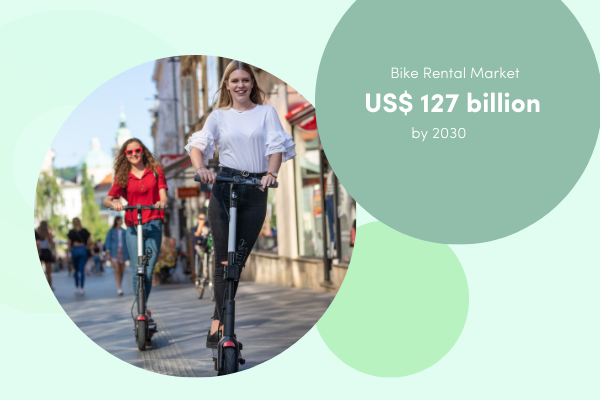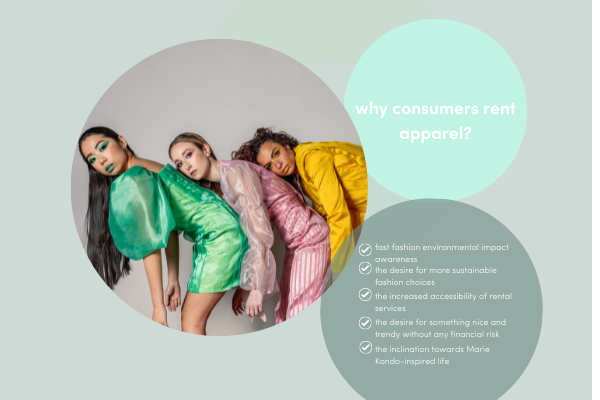Everything can be bought online. 74% of Europeans shop online. Now, that is lovely news if you are on the right side of the fence. However, it can be alarming for your business if your revenue solely depends on a one-time purchase model—you know, you see it, you buy it, the end.
This business model may not be a thing of the past yet, but its relevance is slowly declining since consumers are getting wiser and more sustainable in their purchasing decisions. Hail, circular economy. 👏🏾 In this article, we guide you through how to start a subscription business, especially for product subscriptions.
Product-as-a-service? What is that?
Product as a service, equipment as a service, subscription products or rental products - call it whatever, the underlying concept is the same—a business model in which a consumer does not own the product but simply uses it for a recurring fee. The company (seller) even retains the ownership of the product and gets the product back at the end of the subscription period. After some repairs and refurbishment, the company rents the product to another customer, thus extending the product's life cycle and increasing the revenue earned per product.
So that is a subscription business model explained in simple words.

How is leasing different from monthly subscriptions?
Leasing is often viewed as inflexible, and over the past few years, subscriptions have risen as a more flexible alternative to leasing. Subscriptions also often bundle insurance, maintenance, and other costs at an all-inclusive price which is often more appealing than leasing.
What are some typical business models?
We'll skip the free-floating models and focus on monthly subscriptions instead.
- A manufacturer launching a subscription model: pretty straightforward and easy to understand. A manufacturer of e-bikes that operates in the B2C space launches a subscription service on top of the selling model.
- A retailer launching a subscription model: businesses that acquire bikes from manufacturers and sell or rent them via e-commerce channels.
- Platform-as-a-service: a business model in which multiple manufacturers and retailers offer their products on a subscription basis on a common platform. The platform is often built.

What are you missing if you do not take action?
If you've taken even one lecture in business during your university, you are probably aware of the companies that are titled "companies that failed to innovate and, as a result, are forgotten" 🤦🏻♂️ or, in most cases, are used as examples for "business 101: what not to do" class. 🤷🏾
It pains me to name them, but I'll do so anyway for the sake of this article (and to, of course, make a point):
- Blockbuster: a movie and video game rental service giant that failed to transition towards a digital model.
- Polaroid: known for instant films and cameras but was unable to anticipate the impact of digital cameras on its film business
- General motors: dominated the market for 100 years but ignored competition, ignored product quality, ignored the change in consumer needs and did not invest in new technologies.
- Kodak: could not keep up with the digital revolution and feared the cannibalisation of their strongest product line.
The examples are endless, but the conclusion is the same: Adjust and react to transformations in the industry.
So let us cut the chase and talk about the good stuff. Is the subscription business model suitable for your business? It is if you got physical products that can be rented out. Now, find the juicy details of your business below.
Mobility
Mobility products like cars, bikes, e-bikes, mopeds, and e-mopeds can either be sold for a one-time price (the selling model) or offered to the consumer on a subscription basis (the subscription model).
Yes, it is like Netflix, but for physical products. The consumer pays a recurring fee to get access to a product.
The customer then uses the product and returns it to the seller at the end of the subscription period.
.png)
This type of business model has many names. You might even be familiar with some of them. Mobility-as-a-service, bike-as-a-service, e-bike-as-a-service, rental cars, rental bikes, bike subscriptions, etc., are all terms associated with a subscription business model.
The mobility subscription industry is divided into micromobility and other mobility subscriptions, including cars and RVs.
Micro-mobility Subscription
Micro-mobility subscriptions, why is it a thing?
Three words: convenience, flexibility, low commitment. Let's add "increased awareness about sustainability", which makes it four. But wait, there's a "low financial barrier" that makes it five, and since I can no longer count it on one hand, it's a list.
What is the motivation behind offering micro-mobility products on a subscription basis?
For the customer
- Typically no risk of maintenance or repair cost
- Always a modern, up-to-date product
- Lower financial barrier
- Access to high-quality product
- Increased awareness of sustainability
- Convenience as the seller takes care of getting the product back
- The flexibility of cancelling a subscription at any time
- Low commitment due to low financial barrier
- Decreased use of public transport (especially during the COVID pandemic)
- Change in perspective about bikes (from a recreational mode of transportation to a genuine way of getting around)
- A hassle-free alternative to car ownership
- Shift toward preventive health measures as a result of the ongoing COVID-19 pandemic
For the business
- A way to achieve sustainability goals
- Stable revenue stream in the form of monthly recurring revenue
- Better image in the eyes of the target customer
- Considerably lower customer acquisition cost (CAC)
- Retained ownership of the product
- Learning possibilities about the product and performance in the market
- Control over the repair process
- Better demand forecast
- Better cash flow management
- Closer connection with the customer
- Multiple touchpoints with the customer
- Direct impact on reducing company's CO2 footprint
- Increased revenue per product
There's also a push from the government. As a result of increased congestion on roads, high fuel prices, and high CO2 levels, governments are incentivising infrastructure development that is directly linked to the bike industry. Bicycle-friendly lanes, app-based locks and docking stations, and GPS for bike tracking are all examples of development in the bike industry.

How big is the bike rental industry?
According to research by Fact.MR, the global bike rental market was worth USD 58 billion in 2020 and is projected to grow to USD 127 billion by 2030.
As of 2021, more than two billion bikes are on the street, and this number is expected to be around five billion by 2050.
Who are prime customers for bicycle subscriptions
Bike subscriptions are famous both in B2B and B2C segments. B2 B's target audience comprises food delivery, on-demand grocery, last-mile parcel delivery, company fleet for employees, hotels, resorts, and other hospitality sectors providing a bicycle experience. B2C target audience is spread across age groups and income levels.

A simple google search will yield thousands of results, and it probably doesn't make much sense to look for all thousand of them to take notice of the transformation in the bike industry. But let's talk about some of the most famous ones.
Companies that are already doing it.
A simple google search will yield thousands of results, and it probably doesn't make much sense to look for all thousand of them to take notice of the transformation in the bike industry. But let's talk about some of the most famous ones.
Swapfiets - city bike subscription
Their iconic blue tires are hard to miss and pretty much dominate many streets all across Europe. Their value proposition is "an always working bike." As per their website, they have over 250.000 members in the Netherlands, Germany, Belgium, Denmark, France, Italy, Spain, Australia, and the UK.
TIER Mobility - e-scooter subscription
TIER started with a free-floating model for their e-scooters but launched a subscription service, MY TIER, for their second-live e-scooters in 2021. TIER's growth over the past few years has been impressive. Besides backing massive funding, they are constantly acquiring companies worldwide.
Grover - e-scooter subscription
Anyone who knows Grover knows that they operate in the consumer electronics space. But according to their Growth Report, their e-mobility product, namely Grover e-scooters, saw the highest growth.
When a consumer electronics subscription company says that their e-mobility products saw the highest growth, it must mean something.
Types of bike rentals
- City bike rentals, aka the free-floating model
- Premium bike rentals
- Long-term bike rentals and leasing
- B2B bike rentals
- Sports and leisure bike rentals
Car subscription
Car subscriptions, why is it a thing?
Let's put rising fuel prices, CO2 emissions, and congestion on roads aside and focus on the less obvious reasons why car subscriptions are a thing now.
Owning a car is no longer a lifestyle necessity. Mobility in the 20th century meant owning a car or maybe two or maybe even 3. In the 21st century, it somewhat means the same, though there is an uprising. The younger generation, namely the millennials, think differently about owning a car and mobility in general. The younger generation just wants to get from point A to point B and then to point C. They want connectivity, accessibility, and affordability and, at the same time, to minimize accidents, pollution, and road congestion.

How big is the car subscription industry
The mobility as a service sector is expected to reach USD 1 trillion by 2030, according to a report by KPMG.
Companies that are already doing it?
Auto Maker Subscription
- Volva with its Care by Volvo service
- Genesis
- Jaguar with its Land Rover
- Nissan
- Porsche
Third-party subscription
- Borrow (limited geography)
- Fair
- Hertz My Car (American Rental)
- Sixt (European Rental)
Startups
- Cluno
- Drover
- MaaS Global
- Moovel
- aboDeinauto
the list goes on and on and on.
Furniture Subscriptions
What Are the Opportunities in the Furniture Industry?
There is a future in the furniture industry. Got it? Furniture 🤓. The EU furniture industry is constantly innovating and setting new trends in the global market. In addition to being trendsetters, the EU is also a world leader in the high-end segment of the furniture market. Nearly two out of every three high-end furniture sold in the world are produced in the EU, thanks to the region's highly skilled craftsmen and cutting-edge manufacturing facilities.

How big is the furniture rental economy?
The furniture rental economy has seen healthy growth in the past few years. And yippee, it is expected to continue snowballing in the years to come. The market is anticipated to grow at a 6.8% CAGR between 2021 and 2031. It is estimated that furniture on rent market share will grow from 2021 to 2031, surpassing the US$10 Bn mark in 2031. The market was already valued at US$ 5.3 Bn in 2020 alone. To simplify it—it is a very profitable industry.
.png)
Are there any big names in the furniture rental economy?
Absolutely.
- IKEA (set to include subscription model as part of its business strategy)
- CORT (USA)
- Feather (USA)
- Brook Furniture Rental (USA)
- Oliver Space (USA)
- Fernish (USA)
- Enky (EU)
- Mobelo (Germany)
- Pabio (EU)
- Lyght-Living (EU)
Why does launching a subscription business matter to your furniture business?
If you sell furniture, one of your many doubts must be—do consumers actually use used? Absolutely. A lot fear long-term commitment 😏 and want the flexibility to any upcoming trends. Plus, with the world becoming borderless and multicultural, many do not stay in one place for long.
The furniture rental economy 🛌 is driven by a number of factors, including the increasing preference for renting furniture among millennials 🙌🏻, the growing number of working women, and the increasing disposable incomes 🤑. Additionally, the rising cost of buying furniture and the ever-growing preference for a flexible lifestyle is also playing a role in driving the growth of the furniture subscription economy.
.png)
Germany 🥨 alone draws about 11.5 million foreigners. That said, furnishing a small apartment is deemed stressful and costly. Painfully costly. 😡 It is more convenient and practical to rent furniture and appliances and return them with ease once the customers find their next dream job or destination somewhere else. If consumers know furniture can be rented on a monthly or annual basis, why would one spend thousands of euros for something that has to be disposed of when the next job will be in Bali.🏖️ Or Cape Town.🤷🏽♀️
Ohhh, let's talk about environmental guilt. We mean furniture disposal. 🫠
In Europe, 80% to 90% of the furniture waste in Municipal Solid Waste (MSW) is incinerated or sent to landfills every year. Only 10%, sadly, is recycled.
With this barely tapped market, furniture rental is not a novelty. It is a necessity.
Consumer Electronics
How big is the consumer electronics industry
.png)
By 2026, the global bring-your-own-device and enterprise mobility market is expected to reach $157.3 Billion 🎉, growing at a compound annual growth rate (CAGR) of 16.7%. Devices are projected to record a 15.4% CAGR and reach US$82.4 billion by the end of the analysis period. It screams good business.
How can your consumer electronics business cash in this opportunity?
The COVID-19 pandemic has forever altered the way businesses operate. One of the most progressive leaps is the shift to remote working. 💻
The remote work culture leads to a need for tools that allow teams to collaborate virtually. Enterprise mobility has been a game-changer for businesses across the globe. It has enabled organizations to be more agile and productive while also providing employees with the flexibility to work from anywhere, at any time 😉. On top of this, the bring-your-own-device (BYOD) trend has also been a major driver of enterprise mobility, as more and more employees are using their own devices for work. 🖥️
Important figures on flexible working culture to consider
66% of the workers among 12 500 employees in 29 countries believe employers should allow flexible working despite the waning threat of the pandemic.

The survey found that employees in the United States were the most likely to want more flexible working arrangements, with 78% of respondents saying they would like to see more flexibility from their employers. This was followed by workers in India (75%), Brazil (74%), and Mexico (73%). Workers in the United Kingdom (62%), Germany (60%), and France (59%) were also among those who said they would like to see more flexibility from their employers.
It seems clear that employees around the world are increasingly interested in having more control over their work lives and are looking for ways to achieve a better work-life balance.
So what does this all mean for the future of work and its implication to the consumer electronics industry?
There would be a surge of demand for home office electronics, appliances, and furniture: laptops, desktops, cool noise-cancelling headsets, ergonomic chairs, sit-standing desks, smartphones—the whole shebang.
It would be best if you cashed in this opportunity—not doing so will be a disservice and a failure for your business to adapt to the growing trend.
By the way, circuly is a fully remote team. And many of us rent our gears. 🙌🏽
Why do customers rent appliances or consumer electronics?
With the growth of the sharing economy and the popularity of subscription-based businesses, it's no surprise that appliance rentals are on the rise. A recent study found that almost 60% of all consumers are willing to rent rather than buy if the products are trendy and high-quality. The percentage was even higher for millennial and Generation Z consumers, at over 70%.

Any big names doing tech rentals already?
- Apple is coming up with its own hardware-as-a-subscription.
- Grover (third-party subscription) must be the biggest and has recently expanded to the United States
- Samsung Germany, through Grover
- Lendis (Germany)
- Blue Movement (Bosch NL and DE)
Is there an untapped market for the consumer electronics business?
Surprise, surprise! Unlike the mobility sector, where car companies gradually come up with their own subscriptions, the household and commercial consumer electronics sector barely uses a third-party subscription, and what is more surprising? Big household names have not tapped this additional revenue funnel yet. They better do it before it is too late. It is the era of subscription, after all. 🤔 We are staring at you,
- Dell
- HP
- Lenovo
- LG
- Sony
- Panasonic
Consumer Appliances
Kitchenware and Kitchen Appliance Industry: What's cooking?
A heads-up—This is not about rent-to-own. This is all about subscription-based rentals. Fridge. Oven. Dishwasher. Induction cooktop. Hood. Silverware. Pots and pans. The entire kitchen clan. 🔪 Yes, renting them and returning them when the subscription period is over. It can be for a week. A month. Six months. Or even a year. This appeals to a certain demographic and can certainly be linked to furniture and consumer electronics resources written above.
.png)
Renting kitchen appliances and kitchenware is actually a thing?
You bet. The global appliance rental industry is expected to exceed the US$8.2 billion mark by the end of 2025, owing to the rising millennial population around the globe. The millennial population is highly inclined towards renting appliances, as they frequently change their employment locations. Moreover, the concept of renting appliances is gaining popularity among working professionals and single individuals, as it offers flexibility and convenience.
Is anyone doing kitchen appliance rentals already?
Barely a list, really. A lot of businesses are still fixated on the yawn-inducing rent-to-own models. Eventually, this model will retire and be replaced with a subscription business model.
Third-Party Subscription
- Orent (France, Belgium, Luxembourg, and Switzerland)
- Grover
- Lyght Living (Furniture, Kitchen Appliances, Other Household Furniture)
- Party Rent
- Yes Appliance Rentals (UK)
- Hughes (UK)
- Switch Rentals (UK)
- Essential Rentals
- Homie (Nl)
- Bundles (Nl)
- Wasautomatenverhuur.nl
- Blue Movement (Bosch)
Let's crunch numbers in the housing rentals in the European Union States and
In Germany, long-term real estate rentals do not come with a kitchen. Not even a single bulb. It is as white and naked as a ghastly ghost.
Additionally, city dwellers who live in rental accommodation are much more likely to move than those who own their homes. And what's the figure for dwelling renters? It is about 40-50% in most major European cities. Plus, almost 60% of us live in flats. This is likely due to a number of factors, including the fact that renters may have less financial stability and security than homeowners and may also be more likely to need to move for work or other reasons. Overall, though, the data shows that renters are much more mobile than homeowners, and this is something that should be taken into account when considering furniture, consumer electronics, and kitchen appliance rentals. These three tie so perfectly for a subscription business launch.

On top of the furniture and consumer electronic market, this is also a huge opportunity for big residential appliance brands. This is a barely tapped market. We are waving at you 👋🏽,
- LG
- Gaggenau Hausgeräte
- General Electric
- Miele
- Fisher & Paykel
- KitchenAid
- Samsung
Apparel and Fashion Subscriptions
What's Fashionable in the Fashion Rental Industry
Gucci. Louis Vuitton. Balenciaga. Verdura. Cartier. Bulgari. Name it. Rent it. Luxury goods are not limited to the A-list celebs anymore. 😏
As the world grapples with the ongoing pandemic, the online clothing rental market is witnessing significant changes. In particular, there has been a shift towards subscription-based services.
Through fashion-as-a-service, customers can rent three to four pieces of clothing simultaneously for a limited period for monthly fees. This monthly or quarterly subscription-based model is a growing online clothing rental industry trend, and it allows retailers to reach a broader customer base and generate recurring revenue.

The rental apparel market will rake in up to about $7.5 billion by 2026. 🎉
As the sharing and circular economy grows in popularity, more people 🕺🏻will likely turn to renting or ehem subscribing their clothes instead of buying them outright. This shift could lead to a boom in the rental apparel market, with growth rates reaching 60% by 2022.
Why do consumers rent fashion apparel and luxury goods?
- More inclined towards Marie Kondo-inspired life ✨ If you do not have the size of a Kardashian's walk-in closet, it is better to rent apparel you are going only to wear once anyway.
- Want something new and nice to wear without the financial risk 💵 Let's be honest—we all have that desire to embody glitz and glamour at least once in our lives.
- The increasing environmental awareness of fast fashion🌿A growing number of fashion aficionados want to be fashionable but also eco-friendly. Gotta find that equilibrium.
- The desire for more sustainable fashion choices 🌎 Renting is more sustainable than buying.
- The increased accessibility of rental services 💃🏼 The 21st century meets eCommerce meets subscription economy meets circular economy.

Are any luxury brands doing subscription business?
Big names in the fashion industry can be found in many third-party subscriptions.
By Rotation: Fashion rental app (UK)
Cocoon Club: Bags rental subscription service(UK)
Dresscoded: Buy & rent occasionwear (DE)
Dropkid: Skiwear rental service (DE)
Endless Wardrobe: Buy & rent women's fashion (UK)
Find Rent Wear: Womenswear rental service (UK)
Girl Meets Dress: Dress rental service (UK)
HURR Collective: Designer clothing and bags rental (UK)
Mossbroshire: Men's black tie suit & tuxedo hire (UK)
Myon Belle: Women's occasion wear rental service (DE)
My Wardrobe HQ: Buy & rent luxury designer fashion (UK)
Onloan: Designer clothing rental subscription service (UK)
Rotaro: Rent the latest designer clothing & bags (UK)
SKFK Circular Closet: Rent clothing styled by professionals (ES)
Spinning Closet: Womenswear clothing rental service (NE)
The Devout: Women's & menswear clothing rental subscription service (UK)
Beekman New York: Luxury Fine Jewelry Rental
Haute Vault: Luxury Jewelry and Watches
The list above seems exhaustive already. Are there any opportunities left for the apparel and luxury accessories business?
Nah, they are not that many. For sure, you have noticed it as well. The subscription-based model in the fashion industry remains lacking. They are quite sporadic and limited and still have a huge room of opportunities to explore.
If you are in this line of business (clothes, shoes, accessories, fine jewellery and want to explore a different revenue stream, hit us up for a free live demo. 👌🏻
Baby goods Subscriptions
Doing Really Good Baby Goods
Millennials are shamefully monikered the Boomerang Generation—their financial insecurity made them crawl back to their parents' space—and Trophy Kids—simply showing up was an accomplishment.😏 Still, they surprisingly grew up well, got jobs, and became parents themselves. 🫶
Their awareness of sustainability and climate crisis mould their choices when shopping for their kids' needs.
As the world becomes more and more digitized, it's important for retailers and brands to connect with consumers in a way that feels authentic and human. And what better way to do that than by offering sustainable or environmentally friendly apparel? According to Monitor™ data, nearly six in ten (57 percent) millennial moms say they would be more loyal to a clothing brand that offers sustainable or environmentally friendly apparel and a line of baby goods products.
Any Baby Goods Doing Subscription Already?
The list is getting happier by the day.
Loop Baby: Baby Gear (San Francisco, USA)
Babonbo: Baby Equipment Rental (EU)
Hulaaloop: Baby clothing rental (NL)
Bundlee: Baby clothing rental (UK)
Circos: Kids & maternity clothing rental subscription service (NE)
The Little Rental Company: Organic baby clothing rental (UK)
Stokke: Partnered with circuly
StrollMe: Partnered with circuly
What's the implication of this for your baby goods business?
Every two to six months, baby and young children (3 years and below) clothes and equipment need to be replaced—they outgrow their clothes, furniture, and equipment ever so swiftly. New parents' favourite line: babies grow so fast.
The linear and conventional way is to shop for cheap, unethically laboured-in-developing-countries clothes and gears. But. As we have mentioned above, modern parents are way more sustainable and environmental with their purchasing decisions. Questions they ask among themselves—What's the goods' life cycle? Where is it from? Is it sustainably sourced?
That's where your business comes in. You can absolutely profit from this economic shift in the baby goods industry.
- An additional revenue stream
- Full ownership of your products
- An opportunity for your business to be sustainable and circular
- An expansion of your customer base: traveling families with kids, sustainably nuanced parents, and their ilk
Renting baby goods is sustainable and circular by nature. It is a win-win for your business and for the parents. Be it car seats, strollers, wooden cribs, toy packages, and high chairs. Bring them on! You may already have an existing rental business, or you totally have no clues on how to transition. circuly—a subscription software for physical products—can do it for you.
Here's what you are missing out on
Here's what you are missing out on (major FOMO) if you decide to stick to a selling model and do not think of innovating towards a subscription business model.
- Opportunity to become more sustainable and circular
- Taking ownership of your product
- Tapping into the huge refurbishing and secondhand market
- Recurring revenue
- Stable revenue stream
- An avenue of wider client base
Isn't it intimidating to switch to a subscription business model?
Simple answer. No. Why? Because circuly exists. We offer a sophisticated digital infrastructure for your business. Say ba-bye to labouring through setting up everything. Say ba-bye to staring at the screen waiting for some bookings to get in. Everything is seamlessly integrated into circuly's system.
Sounds like a cashing ka-ching plan? Hit us up for a free live demo.
Future outlook
As we progress through the years, e-commerce will definitely become the new normal, and so will e-mobility solutions. Subscriptions already provide a way to try out these new solutions and become accustomed to them. Increased awareness about sustainability and sustainable business practices are and will continue to pave the way for innovation. Additionally, the COVID-19 pandemic forced masses across the world to look at health from a different lens: to adopt more preventive health changes instead of reactive. All these factors combined, plus changing consumer preferences, indicate a positive future for the subscription economy.

%20(10).png)


%20(25).png)
%20(24).png)





.png)





